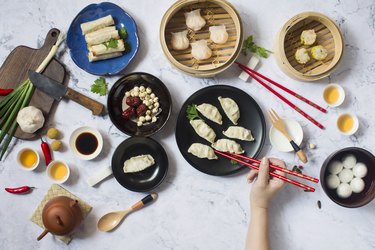
Traditional Chinese dishes consist of readily available ingredients flavored with ginger, garlic and other seasonings. In the United States, Chinese restaurants often use recipes adapted to suit Western tastes, resulting in increased sodium in Chinese food.
The ingredients and cooking methods used to prepare your dishes affect the Chinese food salt content.
Video of the Day
Video of the Day
Sodium in Chinese Food
Some chefs use monosodium glutamate, or MSG, to enhance the flavor of their dishes. Table salt, which is approximately 40 percent sodium, is also used in Chinese cooking. One teaspoon of table salt contains approximately 2,300 milligrams of sodium, according to the USDA.
If you order a dish with soy sauce, it can increase the sodium content of your meal significantly. Just one tablespoon of the sauce has approximately 1,000 milligrams of sodium, according to the USDA.
Read more: 10 Myths About Salt Debunked
High-Sodium Dishes
The U.S. Food and Drug Administration recommends reading the nutrition facts label when looking to reduce sodium intake. According to the FDA, a percentage of daily value of 20 or more means that a dish has high sodium content.
The American Heart Association recommends you take in no more than 2,300 milligrams of sodium daily — less if you have certain health conditions.
A 1-cup serving of wonton soup has 905 milligrams of sodium, while one cup of egg drop soup has 892, according to the USDA. One order of General Tso's chicken, or approximately 2.3 cups, has 2,327 milligrams of sodium — your total sodium intake for a day, according to USDA.
Although vegetables typically have less sodium than other foods, ordering a vegetarian dish is still no way to guarantee you can reduce the sodium content of your meal. One order of vegetable chow mein, or 3.3 cups, has 2,673 milligrams of sodium, according to the USDA.
Lower-Sodium Choices
If you replace one cup of wonton soup with two spring rolls, you will get 360 milligrams of sodium instead of 905. Look for dishes made with steamed vegetables, or ask the chef to use less sauce when preparing your meal. Order condiments on the side instead of pouring them directly on your food.
Reduce the sodium content of your meal by avoiding MSG, sweet and sour sauce, duck sauce and plum sauce. Manufacturers use sodium to enhance and preserve the flavor of canned vegetables.
Cooking your own Chinese food can help reduce sodium content — and eventually, your "taste" for salty foods will decrease. The FDA offers several tips for reducing sodium content in home-prepared foods.
Use fresh or frozen produce whenever possible. If you must use canned vegetables, rinse them to remove excess sodium. Choose fresh meats to use in your Chinese dishes. Processed meats often contain sodium as a preservative.
Instead of adding table salt to your food, use red pepper, garlic or onions to enhance the flavor without increasing your sodium intake. The FDA also recommends eating smaller portions when choosing to consume high-sodium foods.
- American Heart Association: "Shaking the Salt Habit"
- U.S. Food and Drug Administration: Sodium in Your Diet -- Using the Nutrition Facts Label to Reduce Your Intake
- USDA National Nutrient Database: "Soup, Wonton, Chinese Restaurant"
- USDA National Nutrient Database: "Soup, Egg Drop, Chinese Restaurant"
- USDA National Nutrient Database: "Restaurant, Chinese, General Tso's Chicken"
- USDA National Nutrient Database: "Restaurant, Chinese, Vegetable Chow Mein, Without Meat or Noodles"
- USDA National Nutrient Database: "Soy Sauce Made From Soy (Tamari)"
- USDA National Nutrient Database: "Salt, Table"
- USDA National Nutrient Database: "Vegetable Spring Rolls"
- U.S. Food and Drug Administration: "Use the Nutrition Facts Label to Reduce Your Intake of Sodium in Your Diet"
- Columbia Health: Nutritional Differences Between Canned, Frozen and Fresh Veggies
- West Chester University: Sodium
- University of Florida IFAS Extension: Shopping for Health -- Sodium
- USDA Center for Nutrition Policy and Promotion: Dietary Guidelines for Americans, 2010 -- Foods and Food Components to Reduce